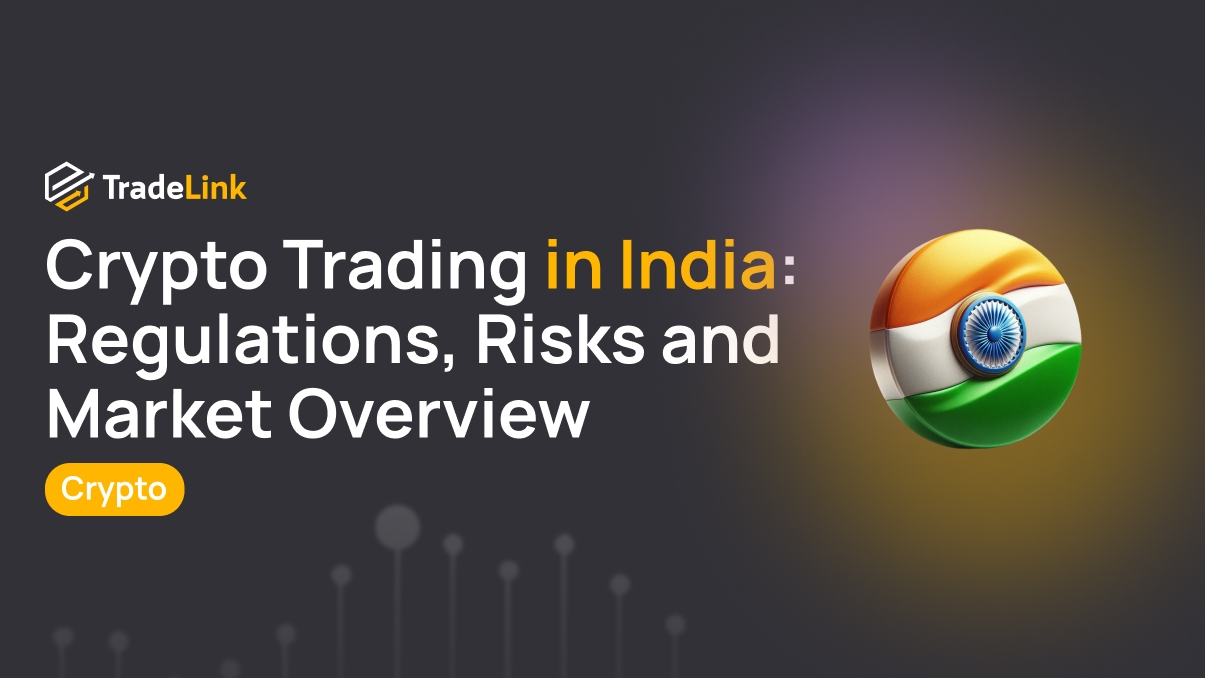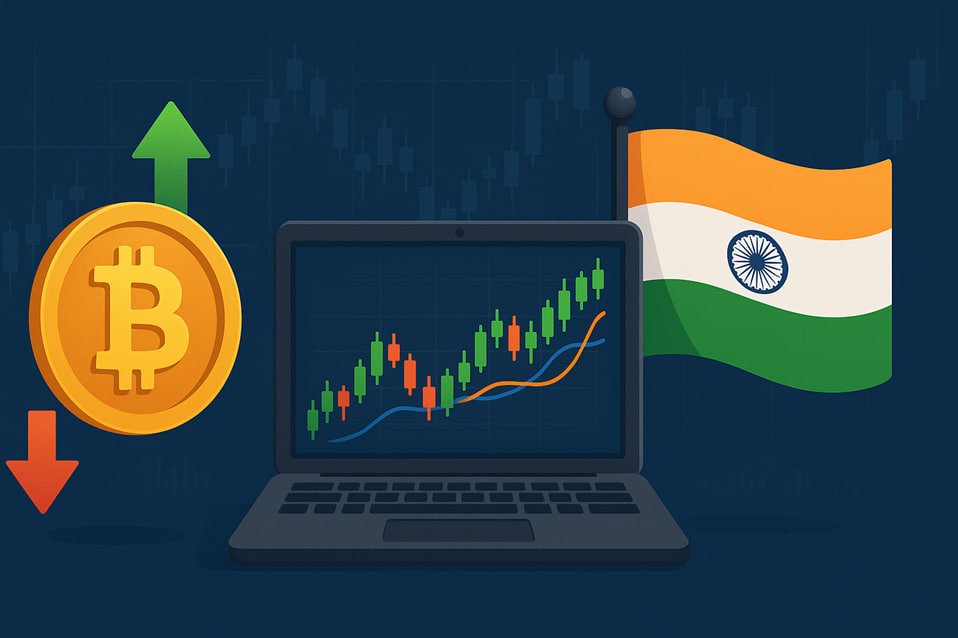Crypto Trading in India: Regulations, Risks and Market Overview

Contents
- Introduction
- What is Crypto Trading and How Is It Represented in India
- How the Cryptocurrency Market Works in India
- Cryptocurrency Regulation in India
- Opportunities and Risks of Crypto Trading in India
- Conclusion
Introduction
Cryptocurrency in India rapidly evolves from a niche interest into a part of everyday financial reality. It’s discussed in the news and draws attention from investors, IT professionals, digital technology enthusiasts, and even small business owners.
After the banking ban was lifted in 2020, the market grew rapidly: legal exchanges emerged, taxes and regulations became part of the discussion, and trading is now possible directly from bank accounts. Cryptocurrency has become accessible and understandable to a broad audience. Many see it as an opportunity to earn with a low entry threshold, especially against rising digital adoption.
Blockchain in India is increasingly viewed as an investment tool and a foundation for new business solutions. This article outlines the key milestones in market development, from lifting the crypto ban to an overview of popular exchanges and practical tips for beginners.
What is Crypto Trading and How Is It Represented in India

Cryptocurrency trading is the process of buying, selling, or exchanging digital assets such as Bitcoin or Ethereum for profit, remittances, or payments.
Trading is regulated: profits are taxed at 30%, and each transaction is subject to a 1% tax. Some banks limit crypto-related operations due to money laundering concerns, pushing people to use direct peer-to-peer (P2P) exchanges.
Popular Digital Assets: Bitcoin in India and Other Tokens
Among the most popular coins in India:
-
Bitcoin is the market leader, known for its high value and is suitable for investments and international transfers.
-
Ethereum is valued for its smart contracts that enable blockchain-based applications.
-
USDT is a stablecoin pegged to the US dollar for international transactions.
-
TRX (Tron) is used for fast and cheap transfers. Due to its low fees, it is especially popular for sending USDT over the TRC-20 network.
-
Solana stands out for its high transaction speed and is popular for quick trades.
Users choose tokens depending on their goals — whether short-term speculation, long-term investment, or fast cross-border transfers.
Indian Crypto Exchanges and International Platforms Available for Trading
India’s crypto market offers many user-friendly solutions for both beginners and experienced traders:
-
WazirX remains one of the most popular local platforms due to its support for IMPS, NEFT, and RTGS and its intuitive interface.
-
If you’re looking for low fees and a wide range of digital assets, CoinDCX is an excellent choice.
-
ZebPay is a trusted and time-tested platform for buying Bitcoin fast and simply.
-
If you’re after advanced tools and a vast selection of assets, check out Binance — a platform offering hundreds of trading pairs, a user-friendly P2P system, and high liquidity.
-
Bybit is also widely used in India, combining a sleek interface with competitive trading conditions.
-
For those looking to earn from crypto without deep market immersion, TradeLink Marketplace is worth trying. It enables copy trading from top-performing traders and investment in carefully curated crypto indexes.
How the Cryptocurrency Market Works in India

The crypto market in India consists of exchanges, wallets, and traders who trade digital assets via online platforms. Prices are driven by global supply and demand, and trading is available 24/7.
Users can buy coins with rupees, hold them in anticipation of price growth, or use them for payments. P2P trading remains popular as it enables direct crypto deals without bank interference.
The market is growing, but traders must remain cautious. Some banks are still wary of digital asset operations, and abrupt changes in regulatory policy may affect access to platforms or funding methods.
How to Start Crypto Trading in India: Exchange Choice, Registration, KYC
To begin trading cryptocurrency in India, choose one of the available exchanges (e.g., WazirX or Binance), sign up with your email and phone number, then complete the KYC process (identity verification using documents such as a passport or Aadhaar card).
Once verified, you can fund your account in rupees and start trading. When selecting a platform, it’s important to consider support for local payment systems, ease of use, and available cryptocurrencies — this will help you get started confidently.
Funding and Withdrawal Methods: Bank Transfers, UPI, P2P
You can fund your exchange account via UPI, bank transfers (NEFT, IMPS), or P2P transactions. If the platform supports UPI, the fastest and most convenient method is usually UPI. P2P trading allows users to exchange rupees and crypto directly among themselves.
Withdrawals work similarly: you sell crypto, and fiat money is deposited into your bank account. Before any operation, it’s crucial to check fees and platform policies — they can vary significantly.
Tools and Trading Pairs Available to Traders
Traders can choose from several trading formats. Spot trading is the most straightforward, as traders purchase and own the cryptocurrency rather than dealing with derivatives.
Futures trading is available on platforms like Binance and Bybit for those seeking more flexibility and willing to accept higher risk. This financial instrument allows you to trade both upward and downward price movements. Futures offer leverage and the potential for quick profits, but come with high volatility and the risk of losing your deposit in sudden market shifts. This format isn’t suitable for everyone and requires caution.
Among the most popular trading pairs are BTC/INR, ETH/INR, and USDT/INR, as well as BTC/USDT, ETH/USDT, SOL/USDT, and other stablecoin pairs. USDT pairs are in high demand because Tether is pegged to the US dollar and available on nearly every exchange. On international platforms that don’t support INR, traders often use USDT pairs to buy and trade crypto — a convenient way to operate in the market without relying on fiat.
Exchanges feature dozens of assets — from major coins like Bitcoin and Ethereum to altcoins such as XRP, DOGE, Avalanche, Aptos, or Arbitrum. Traders can access charts, limit orders, and a standard set of indicators for analysis and planning.
Cryptocurrency Regulation in India

History: RBI Ban, Supreme Court Ruling, Current Status
In 2018, the Reserve Bank of India (RBI) banned banks from servicing crypto exchanges, nearly halting the market. In 2020, the Supreme Court overturned the ban, restoring the ability to trade crypto. Currently, cryptocurrencies in India are legal but under strict oversight. The government classifies them as digital assets rather than currency and requires exchanges to comply with anti-money laundering (AML) rules. Regulation remains tight, and banks sometimes still restrict transfers to exchanges.
Cryptocurrency Law and Government Actions
India has not yet enacted a comprehensive cryptocurrency law, but government agencies are gradually establishing a regulatory framework.
In 2021, a bill was proposed to ban private tokens and introduce a digital rupee, but it was never passed. However, since 2022, the government has implemented strict tax policies: 30% on profits from crypto transactions and a 1% TDS on each trade.
Furthermore, in 2023, crypto platforms were officially added to the list of entities covered by the AML law. This means exchanges must conduct KYC (Know Your Customer) checks, monitor suspicious transactions, and report to financial authorities.
In spring 2025, India’s Financial Intelligence Unit (FIU-IND) also required exchanges to re-verify old and potentially risky accounts.
Thus, the market operates under partial regulation — a formal law is not yet in place, but control is effectively enforced through other mechanisms.
Impact of the Digital Rupee and RBI on the Market
The Reserve Bank of India has launched pilot testing of the digital rupee (e-Rupee) — a government-controlled cryptocurrency. It runs on blockchain but is centralised, unlike Bitcoin. The digital rupee could simplify payments, reduce reliance on cash, and create competition for private cryptocurrencies. RBI wants citizens to use e-Rupee instead of decentralized coins, which could limit crypto market growth in the future. This model is part of the global trend toward CBDCs, which is increasingly discussed amid rising interest in digital finance.
Opportunities and Risks of Crypto Trading in India

Opportunities | Risks |
Access to global markets — trade with international players without intermediaries or restrictions. | Price volatility — sharp price swings can result in losses. |
Fast settlements — low-fee, rapid transfers compared to banks. | Fraud and scams — high risk of encountering fake projects. |
Decentralization — free from single-party control, inflation protection. | Legal uncertainty — lack of clear laws complicates user protection. |
Regulatory Challenges and the Media’s Role
Legal regulation of crypto in India remains unclear: the 2021 bill to ban private tokens and introduce the digital rupee is still pending.
As a result, traders face unpredictable regulatory signals: RBI and other agencies shift positions, while law enforcement and court rulings influence access to banking services. Bank transfers related to crypto may still face delays or restrictions, prompting users to rely on alternative funding methods like P2P platforms.
The media actively covers fraud topics — from deepfake schemes to large-scale investment scams — helping to raise awareness and protect users. At the same time, news reports highlight the growing popularity of cryptocurrencies and user adoption.
Thus, legal and economic uncertainty creates added pressure and complicates access to the market, but India’s crypto space continues to grow regardless.
Conclusion
India’s crypto market continues to evolve despite high taxes, limited banking access, and the lack of a unified law.
The market remains open to those willing to learn how cryptocurrencies work and follow rule changes.
The digital rupee and upcoming legislation could significantly impact the landscape. Still, blockchain already provides users with tools for short-term trading and long-term capital growth, including DeFi platforms and decentralized finance services.
At the same time, choosing a reliable platform with KYC and staying informed about regulations are key to minimizing risks and protecting your assets.